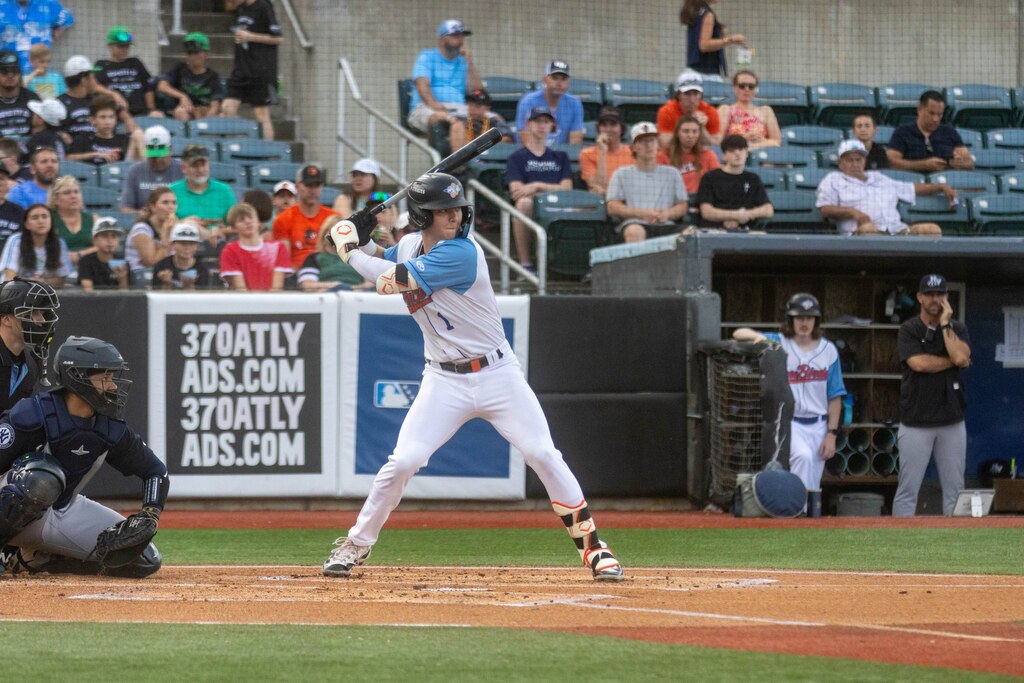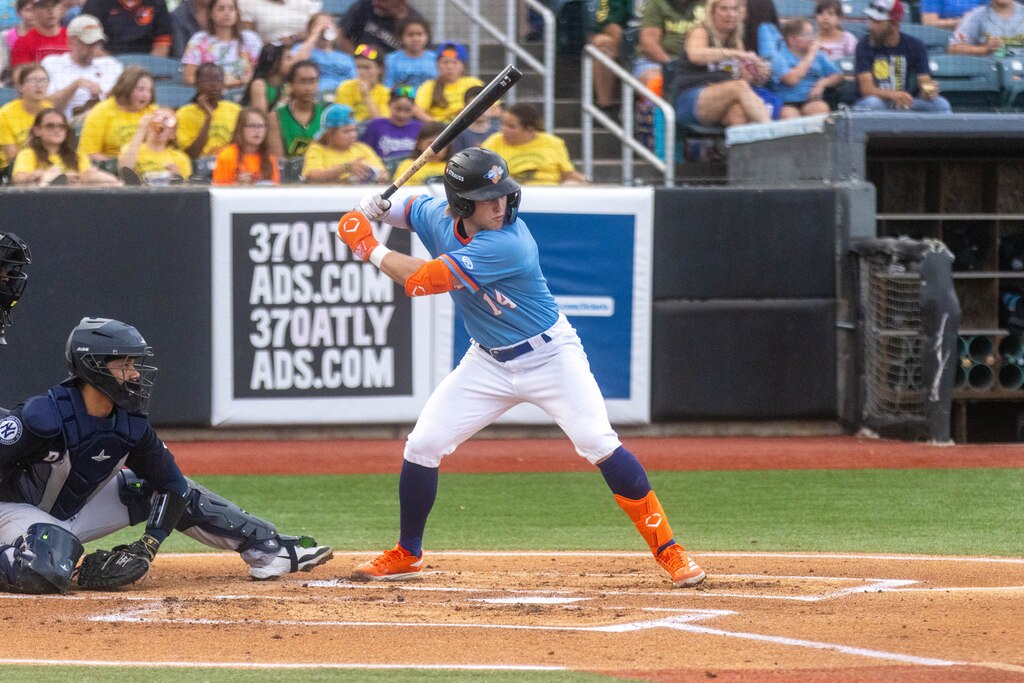If it feels familiar that the Orioles just added another well-regarded crop of college hitters to their farm system with this month’s draft, so too is what’s happening with last year’s batch of early picks at High-A Aberdeen.
An assignment to the IronBirds to start a player’s first full professional season — from the days of Colton Cowser and Connor Norby in 2022 through Dylan Beavers, Jud Fabian and Enrique Bradfield Jr. in subsequent seasons — has typically meant struggles at a challenging level for even the most accomplished college players.
That’s largely been the experience for last year’s top four picks — Vance Honeycutt, Griff O’Ferrall, Ethan Anderson and Austin Overn — who entered the second half of the minor league season collectively on the upswing but with plenty of lumps from the first few months.
Their examples are more extreme, statistically, than in years past, which feels like cause for concern. The staff there feels it’s all part of a process that has ultimately produced players that are better for their issues in Aberdeen.
“We kind of expect it, but it’s [about] how do you respond physically, emotionally, and try to work through it and face that adversity so, as you move up the levels, the adversity hits less frequently?” manager Ryan Goll said. “That’s the development aspect there.”
Hitting coach Zach Cole, in his fourth season at the level, said he’s been open with the players about what’s “kind of a standard first half for the first full-year guys that get thrown into High-A.”
Read More
“Not every team does that with their recent draft picks, starting them in High-A,” he said. “They got through Low-A, learn some things, and they’re starting at that higher level. We saw it with guys like Cowser and Norby, just a lot of learning lessons, creating approaches, learning and seeing these better pitch types.”
Before Aberdeen’s break last week, Cole broke down how these well-regarded players have fared and what success in the second half would look like for each. (All stats entering Thursday’s games.)
Outfielder Vance Honeycutt

- .172 average, .561 OPS, 40.3% strikeout rate, 75 wRC+ in 325 plate appearances
The first-round pick from North Carolina just went on the injured list with an ankle injury. To this point, he has been challenged to make consistent, quality contact.
“It’s been a learning experience, learning how to adjust to our training,” Cole said.
Honeycutt is also adjusting to the pitching.
“For me, it’s just continuing to get his A swing off when he wants to, finding those pitches he can hammer and getting ready to get those off,” Cole said. “We’re starting to see that more, and just building better approaches for himself. That tends to be a standard thing. A college mindset is heaters away and then try to throw some soft stuff. Now, everything is more meticulous. They’re going to try to throw 98 [mph] in, and that’s just something they don’t see much of beforehand, so trying to train those things, seeing better slider shapes and whatnot, just learning how can I be more efficient with my approach.
“He’s doing a really nice job of that and continuing to use that exit velo capability that he has to his benefit. I mean, he hits the ball hard, so continuing to get good angles on those balls when he does crush them. The ceiling is high for him.”
Shortstop Griff O’Ferrall

- .208 average, .586 OPS, 16.7% strikeout rate, 79wRC+ in 348 plate appearances.
O’Ferrall and Honeycutt had polar opposite offensive profiles out of the draft, with O’Ferrall proficient at making contact and controlling the strike zone but lacking the exit velocity. He’s been unlucky in some of his results, Cole said, and they’re constantly pointing out the expected stats when he gets frustrated. But, like others who can make a ton of contact before him, Aberdeen is challenging O’Ferrall not to just put the bat on the ball for the sake of it.
“A big part for him is that contact skill is so good for him that he can afford to be a little more patient, getting his swing off when it’s most optimal because when he does swing, even if it may be a strike, it may not be optimal for us to produce some slug on, especially early, and he doesn’t have to worry as much about striking out or getting behind in the count with that contact skill,” Cole said. “He attacked that early on, has done a tremendous job with that, and then continuing to hit the ball at good angles. He’s been crushing some balls, 95 [mph] at 25 [degrees] lately that have just been right at guys. He’s been doing a tremendous job, and hopefully we continue to see those balls turn into hits.”
Catcher Ethan Anderson
- .211 average, .589 OPS, 20.5% strikeout rate, 79 wRC+ in 210 plate appearances.
Anderson, the Orioles’ second-round pick a season ago, started hot with an .810 OPS in April but has fallen off since, without a multihit game or home run since the beginning of May. Cole said he, too, is running into some bad luck, and that the focus is going to be on quality of contact from both sides of the plate.
“For us, just continuing to work on the swing path and influencing the ball flight,” Cole said. “Sometimes he can get a little bit of topspin going, and he’s been doing a great job of attacking the things we need to do to clean that up. And it’s starting to show more and more. … He works incredibly hard as well.
“It’s just some angle work, making sure we’re hitting some pull-side, oppo-angle work, making sure the barrel’s working through the hitting zone as long as we can, and optimizing that contact capability.”
Outfielder Austin Overn
- .232 average, .704 OPS, 28.4% strikeout rate, 114 wRC+ in 303 plate appearances.
The standout of the group, Overn is one of the more intriguing prospects in the Orioles’ system for his speed and untapped offensive potential. Cole noted that he’s been incorporating bunt hits into his arsenal more, given that simply getting on base with his speed means he’s likely going to be in scoring position quickly.
“He’s been doing a great job of that and, when he’s getting his swing off, he’s got a really good chance of hitting the ball hard,” Cole said. “High exit velo capability along with the speed, he’s a dangerous player that can play a really long time.”
Overn, like the rest of the college products, is figuring out how he’ll be pitched in pro ball, which is the next step in all of their developments.
“It’s almost a broken record, but continuing to form those approaches of how pitchers may attack him and what’s going to be most conducive to what his swing can produce,” Cole said. “He’s learning those lessons, and they’re really starting to click for him. This is about the time where a lot of it starts to click with these guys. It just takes a ton of practice and a ton of repetition.”




Comments
Welcome to The Banner's subscriber-only commenting community. Please review our community guidelines.